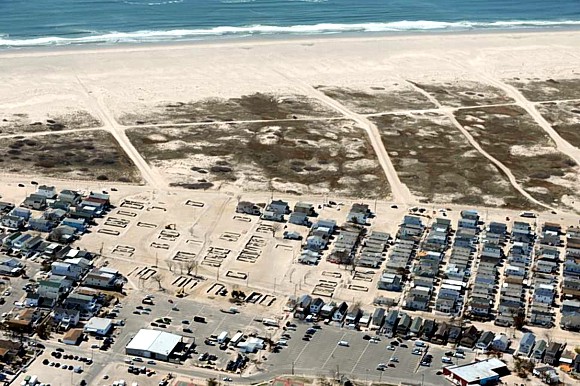New York City has received the first phase of federal approval for a coastal flood protection infrastructure plan for the community of Breezy Point, Queens.
 An aerial photo taken April 26, 2013, showed how Breezy Point, Queens, looked six months after Superstorm Sandy devastated the area. Photo courtesy of DailyNews.com.
An aerial photo taken April 26, 2013, showed how Breezy Point, Queens, looked six months after Superstorm Sandy devastated the area. Photo courtesy of DailyNews.com.The plan will include building a double dune barrier system, along with other bayside flood and erosion protection measures to protect the community from future damage from extreme weather.
Breezy Point is located on the westernmost end of the Rockaway Peninsula of Queens and suffered some of the city’s worst damage from Hurricane Sandy. Waves struck from the Atlantic and rising waters poured into the community from Jamaica Bay.
The mayor’s office reported that storm damage in the area included electrical power systems and sparked “fires that ultimately consumed135 homes.” Overall, about 350 homes in the area were lost as a result of Sandy.
The newly proposed dune system would continue the existing dune line on the Atlantic side of Breezy Point. This would provide natural flood and erosion protection using the area’s natural features.
The city says that the dunes will be designed to withstand a sea level rise of about 2.5 feet in the area over the life of the project.
In addition, it’s planned that these measures will be complemented on the bayside of Breezy Point and Roxbury by constructing bay walls and groins to combat flood and erosion.
The federal government has awarded $1.2 million for the first phase of this plan which is to support technical and feasibility analyses for the project as well as permitting.
The city says that the estimated cost of the double dune system is expected to reach about $20.6 million and the estimated cost of the bayside protection is expected at about $37.6 million. In total, it’s expected that the total cost of the project including design, engineering, and construction will run about $60 million.
The project is receiving support as part of the federal government’s Hazard Mitigation Grant Program (HMGP), which is part of FEMA. The agency says it will provide 75 percent reimbursement of eligible costs, up to the amount of the award.
FEMA provides HMGP funds for states to administer grant programs supporting local hazard mitigation planning and long-term hazard mitigation measures to reduce losses of life and property resulting from natural disasters.
To offset the financial burden of Breezy Point, New York City says that it has “committed its disaster recovery resources for the remaining 25 percent” of the costs.
On a broader scope, in an effort to aid Long Island resident against future severe damage from super storms, the NYS Dept. of Environmental Conservation (DEC) has signed a legal agreement with the U.S. Army Corps of Engineers and Suffolk County.
This agreement sets in motion a three-phase coastal storm risk reduction project along Suffolk County’s Atlantic coast that’s estimated to reach a total cost of $207 million.
The project will include the construction of new dunes and beaches in the 19-mile stretch between the Fire Island Inlet and Moriches Inlet.
Suffolk County plans to use the state funding to acquire 41 parcels of “at-risk” privately owned land and “more than 400 permanent easements (rights to use the property of others) on Fire Island” to facilitate the placement of the protective dunes.
The post-Sandy assessment by New York Governor Andrew Cuomo’s office revealed that on average, the dunes lost about 55 percent of their pre-storm volume, or roughly 4.5 million cubic yards of sand.
The governor’s office said that about 7 million cubic yards of sand will be used for the project, and illustrated the massive volume of sand needed by explaining that a large dump truck only carries roughly 20 cubic yards of sand.
Work on the first phase of the Fire Island Inlet to Moriches Inlet (FIMI) project will begin this fall at Smith Point County Park. And, a second construction contract will be awarded later this year for work in Robert Moses State Park and the Fire Island Lighthouse tract.
The third phase of the project will include 17 Fire Island communities and begin after the necessary real estate access has been obtained. The FIMI project is targeted for completion in late 2016.
The governor’s office said that the funding announced for this project will ultimately be reimbursed by the federal government under the Disaster Relief Appropriation Act of 2013.
The project is a subset of the larger Fire Island to Montauk Point (FIMP) project that will also involve elevating or raising about 4,500 high-risk structures on Suffolk County’s mainland to limit the damage from future storms.
The governor’s office also said that New York has asked the Army Corps to consider extending sewers service to all elevated structures as part of the FIMP project to help reduce the amount of nitrogen pollution flowing into the bays, and thereby also further protecting the coastal marshlands.
Reader comments and input are always welcomed!